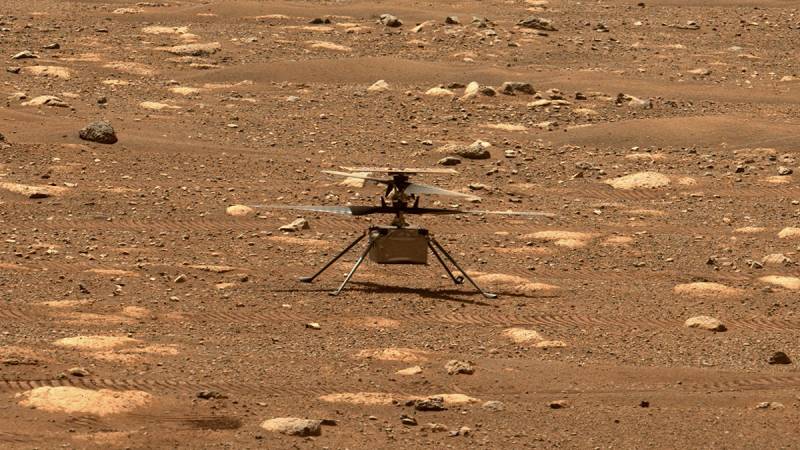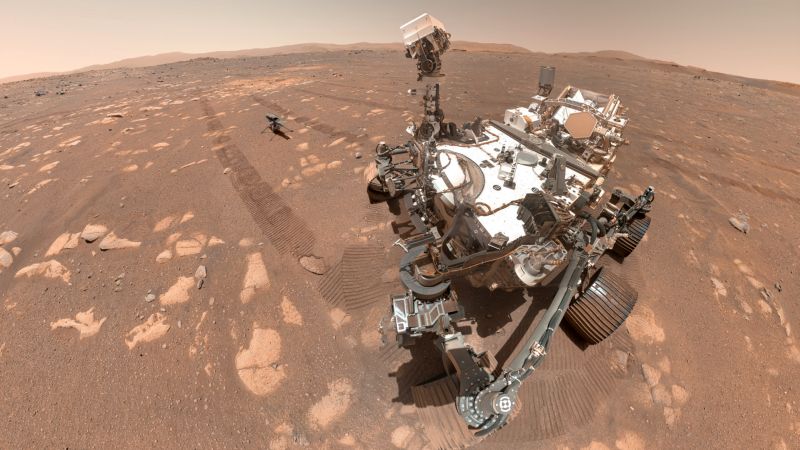The only helicopter on Mars has done it again.
Ingenuity took off on its fourth flight Friday, reaching an altitude of 16 feet and traveling a distance of almost three football fields — 872 feet — round trip, its longest sojourn yet. Airtime: Just short of two minutes.
Not even 2 feet tall, the spunky flier is part of NASA’s Perseverance mission, which has been exploring Martian terrain for over two months, and is still checking off first-ever achievements in planetary exploration from its ambitious to-do list.
The Perseverance rover and its helicopter sidekick — nicknamed Percy and Ginny by some team members at NASA’s Jet Propulsion Laboratory — are just as busy proving technology concepts for future Mars missions as they are conducting scientific exploration.
Besides the ever more daring flights by Ingenuity, the latest technical feats include Perseverance manufacturing oxygen directly from the Martian atmosphere.
Making 10 Minutes of Oxygen
To explore what valuable natural resources Mars offers future human missions, Perseverance has the MOXIE.
Actually, that’s the Mars Oxygen In-Situ Resource Utilization Experiment, a small, double-shoebox-sized device designed to produce up to 10 grams of oxygen per hour directly from the planet’s thin carbon dioxide atmosphere.
On April 20, MOXIE produced 5 grams of oxygen by heating carbon dioxide to over 1,400 degrees Fahrenheit. Five grams may not seem like much, but it’s enough to last an adult for about 10 minutes of breathing.
Future human missions would benefit hugely from making their own oxygen on Mars, not only for humans to breathe, but for making rocket fuel. On a planet where free oxygen is scarce, astronauts will breathe easier if they are not dependent on supplies brought all the way from Earth. The first quick visits to Mars will probably rely on stored oxygen, but longer habitations will require astronauts to tap such a valuable resource, as well as water, where they find it, living off the land.
Ingenuity Aces Flying Tests
The Mars Helicopter’s mission to demonstrate the feasibility of aerial exploration of the planet got off to a flying start on April 19 with the first-ever powered flight on another planet, a 40-second hover maneuver that lifted it about 10 feet off the ground. But this was only the beginning of a 30-day testing program still underway.
If the altitude of 16 feet attained by the helicopter on Friday and the flight before doesn’t seem very high, consider that Mars’ atmospheric pressure at ground level is equivalent to Earth’s at an elevation of 100,000 feet. Ingenuity’s feathery 4-pound weight and specially designed twin rotors spinning at 2,500 rotations per minute allow it to fly where conventional helicopters couldn’t.

What’s ahead for Ingenuity? NASA just announced that the helicopter’s mission has been extended by an additional 30 days, and will enter a new phase of flight testing following its sixth flight in about two weeks.
After that, unless NASA adds another extension, Ingenuity will be grounded and the rover will move on with its mission to search for clues of past life on Mars.
Asked if “Ginny” could be used for reconnaissance to aid the rover’s scientific mission, one JPL team member commented there is no need since “Percy’s” general route has already been mapped out and the rover will drive autonomously between programmed points of scientific interest.
Jon Brooks contributed to this post.

